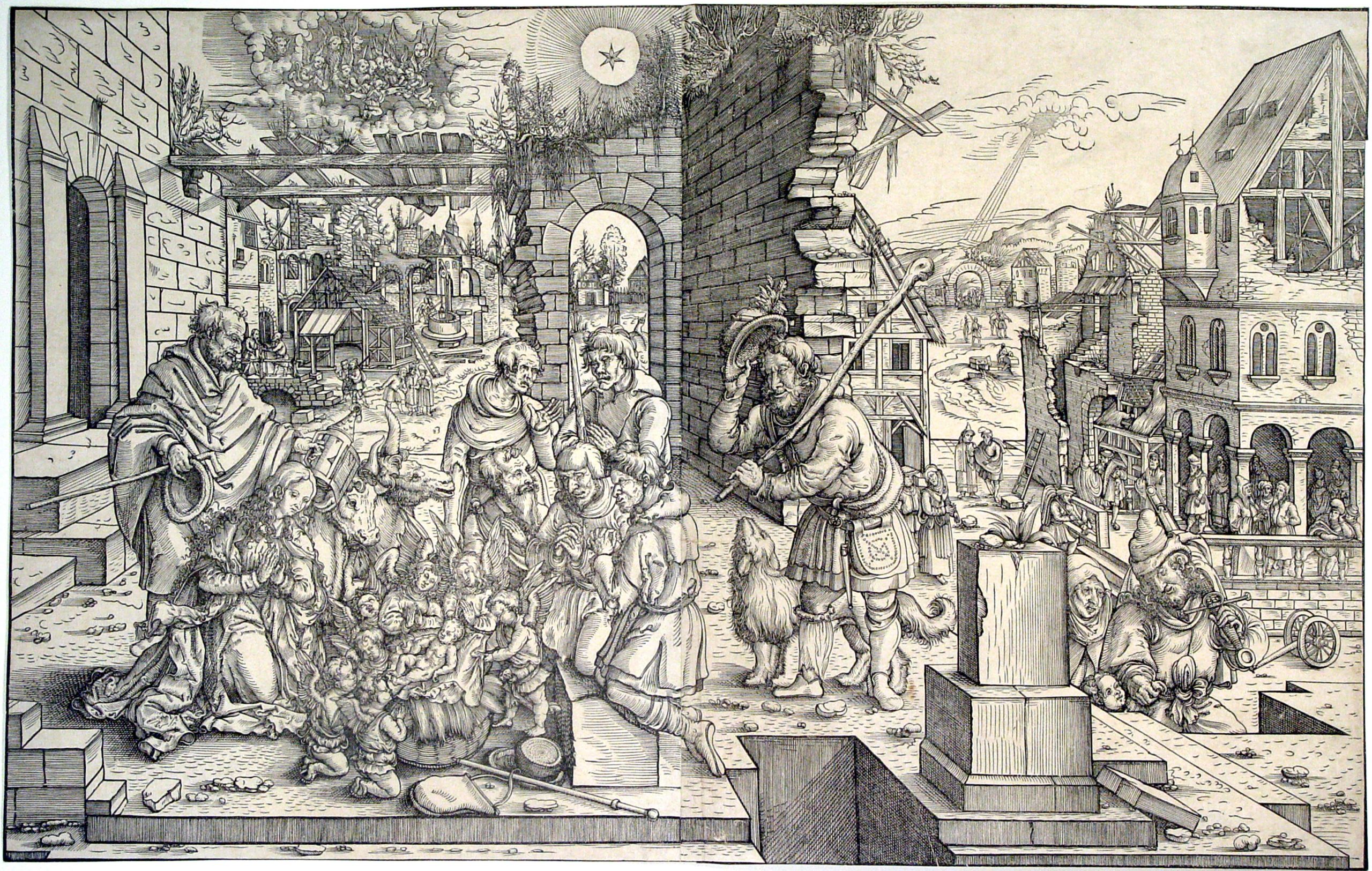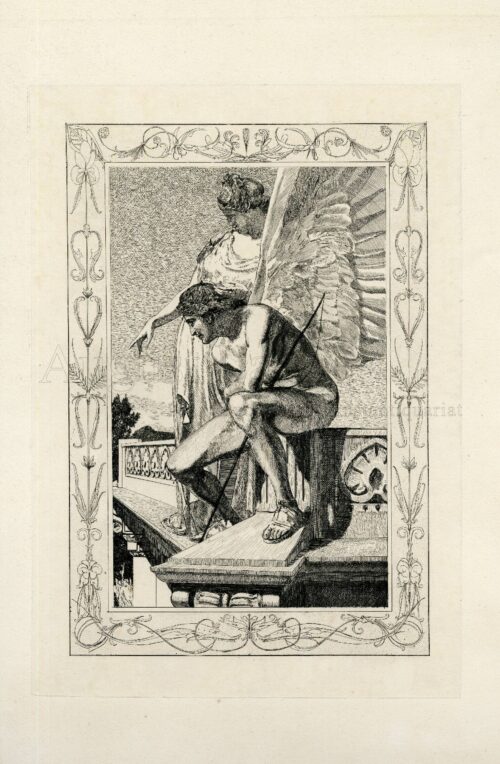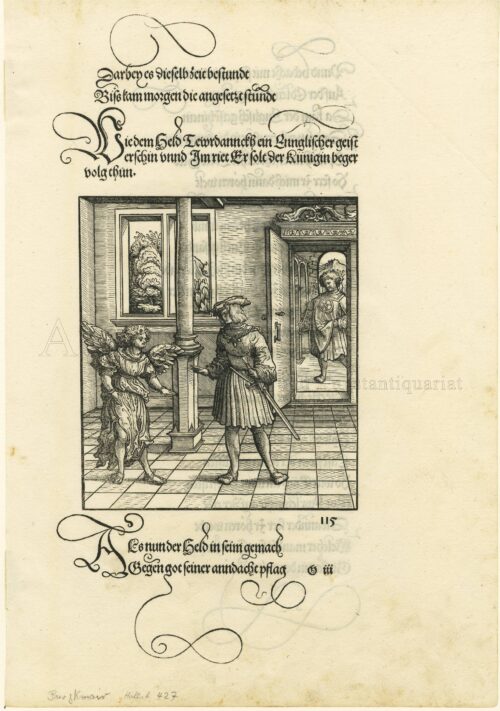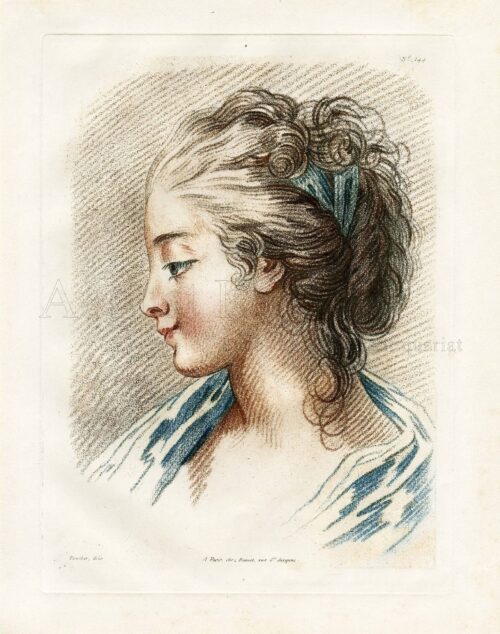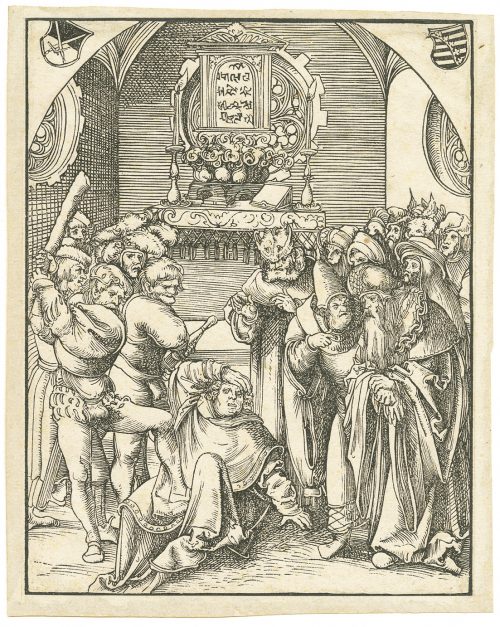Beschreibung
JACOB LUCIUS der Ae.
Anbetung der Hirten.
Holzschnitt, gedruckt von zwei Blöcken auf zwei zusammen gefügten Bögen. Wasserzeichen: Zwei verschiedene vertikale Hörner. Formschneider‘s monogramm auf dem Brunnen WS . 32,7:51,4 cm.
Hollstein XXIII.20.8.i; Röttinger 13, Erster Zustand; Nagler Mon. V Nr. 1904; C. Dodgson, II, 396 no. 1; Strauss II, 635; Strauss-Geisberg, 1974 no. 954-3.
Jacob Lucius (Lutsch), 1530 in Klausenburg oder Kronstadt geboren, wird erstmals als Mitarbeiter in der Werkstatt und Druckerei von Kaspar Helth in Klausenburg erwähnt. Helth betrieb seine Presse von 1550 bis 1600, und in dieser Zeit veröffentlichte er genau 208 Bücher. Er war für die ungarische Kulturgemeinschaft äußerst wichtig, da er die ersten Bücher in ungarischer Sprache herausgab. Jakobus Lucius der Ältere, mit bürgerlichem Namen Lutsch, verließ 1556 die Druckerei des Humanisten Helth und ließ sich in Wittenberg als Zeichner und Formschneider nieder. Anfangs war er bei Hans Lufft angestellt, doch bald konnte er eine eigene Druckerei eröffnen. Als Druckermarke wählte er ILCT, “Iacobus Lucius Coronensis Transsylvanus”. In dieser Zeit erfand er eine Technik, die den Buchdruck in Deutschland revolutionierte. Er entwickelte ein spezielles Verfahren, das es ihm ermöglichte, Kopien von Holzstöcken in Metall zu giessen. Mit den aus eigenen und fremden Holzstöcken hergestellten Metallklischees erfüllte er den Bedarf und die wachsende Nachfrage nach kostengünstigem Bildmaterial, insbesondere für die kleineren Druckereien. Hollstein verzeichnet 68 Arbeiten von ihm. Die meisten dieser Blätter sind in seiner Zeit in Wittenberg entstanden. Nachher scheint er nur mehr gelegentlich zu Reissfeder und Schneidemesser gegriffen zu haben. Sechs dieser Blätter sind datiert zwischen 1555 bis 1556. [625010].
Adoratio of the Shepherds.
Woodcut printed from two blocks on two sheets of laid paper (joined).Watermarks: Two different vertical horns. Cutters monogram in the fountain WS . 32,7:51,4 cm.
Hollstein XXIII.20.8.i; Röttinger 13, First state. Nagler Mon. V Nr. 1904; C. Dodgson, II, 396 no. 1; Strauss II, 635; Strauss-Geisberg, 1974 no. 954-3.
Jacob Lucius (Lutsch), born in Klausenburg or Kronstadt in 1530, is first mentioned to be working in Kaspar Helth’s workshop and printing studio in Klausenburg. Helth operated his press from 1550 to 1600, and during this period he published exactly 208 books. He was extremely important o the Hungarian cultural community, because he published the first books in the Hungarian language. James Lucius the Elder, with civic name Lutsch, left the printing shop, of the humanist Helth, in 1556, and resettled in Wittenberg as a draftsman and form cutter. In the beginning he was employed by Hans Lufft, but soon he was able to open his own printing shop. For his printer’s mark, he chose ILCT, „Iacobus Lucius Coronensis Transsylvanus“. During this period, he invented a technique that revolutionized book printing in Germany. He developed a special process that enabled him to cast copies of woodblocks in metal. With the metal clichés made from his own and other printers woodblocks he met the needs and growing demand for cost-effective image materials, especially for the smaller print shops. Hollstein lists 68 works by him. Most of these sheets were created during his time in Wittenberg. After that, he seems to have used a drawing pen and a cutter only occasionally. Six of these sheets are dated between 1555 and 1556. [625010].
Woodcut printed from two blocks on two sheets of laid paper (joined).Watermarks: Two different vertical horns. Cutters monogram in the fountain WS . 32,7:51,4 cm.
Hollstein XXIII.20.8.i; Röttinger 13, First state. Nagler Mon. V Nr. 1904; C. Dodgson, II, 396 no. 1; Strauss II, 635; Strauss-Geisberg, 1974 no. 954-3.
Jacob Lucius (Lutsch), born in Klausenburg or Kronstadt in 1530, is first mentioned to be working in Kaspar Helth’s workshop and printing studio in Klausenburg. Helth operated his press from 1550 to 1600, and during this period he published exactly 208 books. He was extremely important o the Hungarian cultural community, because he published the first books in the Hungarian language. James Lucius the Elder, with civic name Lutsch, left the printing shop, of the humanist Helth, in 1556, and resettled in Wittenberg as a draftsman and form cutter. In the beginning he was employed by Hans Lufft, but soon he was able to open his own printing shop. For his printer’s mark, he chose ILCT, „Iacobus Lucius Coronensis Transsylvanus“. During this period, he invented a technique that revolutionized book printing in Germany. He developed a special process that enabled him to cast copies of woodblocks in metal. With the metal clichés made from his own and other printers woodblocks he met the needs and growing demand for cost-effective image materials, especially for the smaller print shops. Hollstein lists 68 works by him. Most of these sheets were created during his time in Wittenberg. After that, he seems to have used a drawing pen and a cutter only occasionally. Six of these sheets are dated between 1555 and 1556. [625010].
Preis auf Anfrage / Price on request


